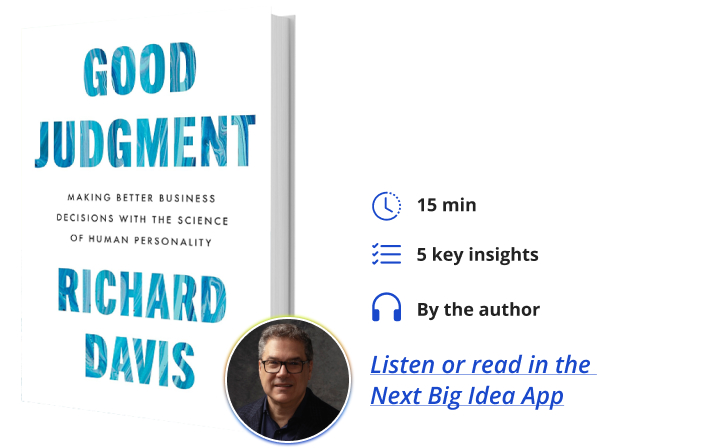Dr. Richard Davis is an organizational psychologist and managing director at Russell Reynolds Associates. He has extensive experience advising CEOs, including those leading Fortune 100 companies. Clients include Meta, Under Armor, Best Buy, Target, the NBA, Time Warner Cable, Dell, Microsoft, Apple, Nike, Starbucks, Amazon, GM, Walmart, Home Depot, United Health, and Google.
Below, Richard shares five key insights from his new book, Good Judgment: Making Better Business Decisions with the Science of Human Personality. Listen to the audio version—read by Richard himself—in the Next Big Idea App.

1. Good Judgment is about people.
We tend to think of judgment as analytical decision-making, detached from the people who influence those decisions. You have a choice between one action and another; one will be right, and the other will be wrong; and that will be determined based on the facts related to the decisions. A million books have been written on how to get the facts sorted out properly and how to avoid cognitive biases.
Good judgment is actually good judgment about people. Essentially, we are a function of the decisions we make in our lives, the sum total of those decisions, and most of those decisions involve people. Who you are friends with, who you date or marry, where you live and work, who you hire, how you raise your kids; all involve judgments about people.
Many of life’s most important decisions rely on who we choose to surround ourselves with and how much faith we put in them. It’s not only about decisions either. How we deal with relationship issues or work situations depends on our understanding of those around us. Knowing how to effectively navigate a tricky situation, as we all do at different times in our careers, hinges on our insight into the nature of the people we are dealing with. The end result is this: Get better at judging others, and you will live a happier, more successful life.
2. We have an innate human ability to understand others.
A cognitive muscle called perceptivity enables us to have insight into people. It’s my experience that successful people have that ability, and they have a competitive advantage over others in work and life. Think about people in your life who just seem to have a sense about others—the people who are shrewd, who seem to surround themselves with other successful people, who often have happy home lives and well-adjusted kids. They’re also great negotiators and always seem to come out ahead.
All of this is because they understand others. They get people and what makes them tick. The interesting thing is that perceptivity is a muscle we can build. You can get better at it, and we are all well advised to do so. Building perceptivity is about getting smarter in understanding people, the nature of their dispositions, and how you can use the knowledge of their personality to make better decisions.
“We’ve all learned strategies to mask who we really are.”
It also involves particular techniques helping to draw out and expose others’ personality traits. That’s not always easy because we make all kinds of cognitive errors in sizing people up, and people are protective. We’ve all learned strategies to mask who we really are. Learn how to cut through the noise in sizing people up, and you end up with a kind of x-ray vision into others. It is a literal superpower that you can harness to make better life decisions.
3. We are at risk of losing our innate ability to read others.
Perceptivity will atrophy over time if you don’t use it, and we are using it less and less as a society. A big reason is that we’re not looking at each other. Our heads are in our phones, we meet people through Zoom, we date people based on their profiles and pictures, and we are getting less comfortable talking to people in general. Our kids text rather than talk, listen, and observe. They are using ChatGPT for literally everything now because they don’t know how to understand or deal with people.
A similar thing happened to another cognitive skill: wayfinding. We used to have a natural ability to figure out in our head how to get from point A to point B. Then what happened? GPS comes along, and we can suddenly outsource this cognitive exercise. The same thing is happening with respect to our insight into others.
We just aren’t looking at each other and paying attention. If you are listening to this in a public space, look around. People probably have their eyes glued to their smartphones. I was recently struck by some signage I saw at the Toronto airport. As you exit the baggage claim area, directions are now brightly projected on the floor—basically light-up signs on the ground rather than the traditional signage you’d normally see overhead. I’m convinced they added these signs because people’s attention is now focused down instead of up or at eye level.
We need to collectively “look up.” To really pay attention to others. We need to exercise that perceptivity muscle in order to understand people and make better decisions in our lives. It’s time to rediscover our childlike curiosity about others and bring this into our daily professional and personal lives.
4. Emotional intelligence is overblown.
Insight into personality is dramatically more important than EQ. In fact, most of what you probably know about EQ is probably wrong. Let me explain.
When talking about having insight into other people, everyone points to emotional intelligence. Nearly all job descriptions have EQ as a desired candidate attribute. You can find articles about every great leader in history showing signs of EQ. There are tests, courses, certifications, books, EQ consultants, and experts. The EQ industrial complex fuels an entire economy around emotional intelligence. We’ve just accepted the notion that you need EQ to understand people better. The fact is, however, that research doesn’t support it. It’s way overblown.
The original concept of EQ, developed in the late 80s and early 90s, was real. Psychologists Peter Salovey and John Mayer introduced the core concept, which they considered to be the ability to recognize and understand emotions. When they published the research, it didn’t raise too many eyebrows. Soon after, though, Daniel Goleman wrote a book, Emotional Intelligence, which really took off. It was literally on the cover of Time magazine as the most important thing since sliced bread.
“Empathy is not EQ and shouldn’t be confused with it.”
Unfortunately, there was one critical problem: Goleman had dramatically altered the concept to mean something very different from the original research and didn’t have the science to back it up. He made EQ into a disposition, not an ability. The disposition was nice, but it was not EQ. Things like empathy and social acumen became EQ.
I am all for empathy, and it is so important, but empathy is not EQ and shouldn’t be confused with it. As a result, EQ sounded great and while it felt like it should be something, it just wasn’t. I really want to stress that emotions are no doubt helpful to understanding people, but they are fleeting states. Personality is enduring, and traits are much more predictive of behavior than states. While it’s helpful to understand if a person is angry, it’s much more powerful to know that they are an angry person. So, don’t worry so much about understanding people’s emotions; instead, focus your energy on understanding their core personality.
5. The Personality Blueprint.
The best way to understand people is to categorize what you see into five key boxes, called the Personality Blueprint. The blueprint is based on one hundred years of research in personality psychology. Over that time, psychologists came to understand that there are five underlying, fundamental personality traits. All other traits fall under these categories. Thousands and thousands of research papers have been published on this finding, to the point where we now call these the Big Five. Nearly all psychologists agree with the structure. The Personality Blueprint is an adapted and developed method you can use to understand people much more clearly.
When you are meeting with someone you want to understand better, imagine you have five boxes in front of you. The first is labeled as intellect; in that, you will put insights about how that person thinks. The second is sociability, or how this person engages with other people. Then there is emotionality, which is how they express their feelings. Fourth is their drive, or why they do what they do. Finally, there is diligence, which is how they get things done or approach work.
Every time the person says something that reveals something about their personality, imagine putting it in one of the five corresponding boxes. Even better, ask questions to help you fill up each box as much as possible. After not too long, you will be surprised how rich your insights are about the person. You will then be in a much better position to make a judgment call about them. This idea of using the structure of personality to categorize and, therefore, understand behavior is important.
Think about all the information you get when you are meeting someone. You are across the table from them, and they are telling you about themselves—there is very rich data there! But it’s difficult to keep up, hard to make sense of, and overwhelming in nature. It’s the Too Much Data problem, and it makes it impossible to do anything with the information you are observing. An analogy is that it is much easier to carry a bunch of papers in boxes than trying to loosely gather them up in your arms. Stuff falls or gets lost, making it hard to understand it all. Instead, using the Personality Blueprint to organize and make sense of dispositional information will lead to a much better understanding of the person in front of you.
To listen to the audio version read by author Richard Davis, download the Next Big Idea App today:































